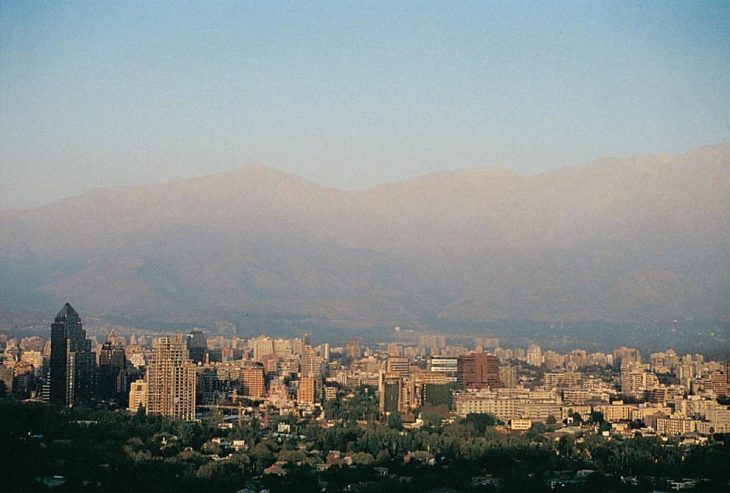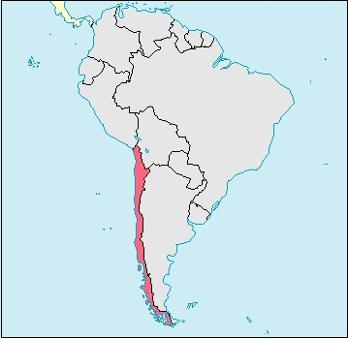What is the Capital of Chile? Santiago

Capital City of Chile: Santiago
City Overview
Santiago, the capital and largest city of Chile, is a dynamic metropolis that plays a pivotal role in the nation’s political, cultural, and economic life. Located in the central valley of Chile, Santiago is strategically positioned between the imposing Andes mountains to the east and the coastal mountain range to the west, creating a natural basin that offers stunning views of the surrounding topography. With a population of over 7 million people, Santiago is the largest city in Chile, representing approximately 40% of the country’s total population. The city’s importance extends beyond its sheer size—it is the heart of Chile’s financial, cultural, and political systems.
The city was founded on February 12, 1541 by Spanish conquistador Pedro de Valdivia, who named it “Santiago del Nuevo Extremo.” It is one of the oldest cities in South America, with a rich history that spans the colonial, republican, and modern periods. Over the centuries, Santiago has grown from a small colonial settlement into a bustling metropolis that blends modern infrastructure with colonial-era architecture.
Today, Santiago serves as the country’s business and financial hub. Chile’s economy is highly centralized in Santiago, with the city being home to major commercial sectors such as mining (especially copper), finance, technology, and trade. Santiago’s metropolitan area spans approximately 641.4 km², with the city itself accounting for a large portion of Chile’s GDP. The city has an advanced public transportation network, including the Santiago Metro, one of the largest and most efficient metro systems in Latin America, making it easy for residents and visitors to navigate the sprawling urban landscape.
Area: 641.4 km²
Population: Approximately 7.1 million (2023)
Time Zone: Chile Standard Time (CLT), UTC -4:00; Chile Summer Time (CLST), UTC -3:00
Highest Mountain: Ojos del Salado (6,893 meters), located in the Andes Mountains, is the highest active volcano in the world and the highest point in Chile.
Longest River: The Maipo River, which runs from the Andes through the Santiago Metropolitan Area and is essential for water supply and irrigation.
Geographically, the city lies at an elevation of 520 meters (1,700 feet) above sea level, which helps create a semi-arid climate typical of the region. However, the presence of the Andes and coastal ranges significantly impacts the weather patterns and provides the city with a unique combination of natural beauty and urban vibrancy.
Major Landmarks
Santiago boasts an array of historical, cultural, and natural landmarks that capture both its colonial past and its modern character. These landmarks are not only popular tourist attractions but also central to the city’s identity:
1. Plaza de Armas
The Plaza de Armas is Santiago’s historic and symbolic heart. Located in the downtown area, this public square has been the center of the city since its founding in 1541. Surrounding the plaza are some of Santiago’s most important buildings, including the Metropolitan Cathedral of Santiago and the National History Museum, both of which date back to the colonial era. The square remains a focal point for public gatherings, protests, and cultural events. It’s a great place to start exploring the city’s historical and architectural treasures.
2. Cerro San Cristóbal
One of Santiago’s most iconic landmarks is Cerro San Cristóbal, a hill located in the heart of the city. Standing at 880 meters (2,887 feet), the hill provides panoramic views of Santiago’s urban sprawl as well as the snow-capped Andes mountains to the east. At the summit, visitors will find a large statue of the Virgin Mary, a popular spot for locals and tourists alike to take in the spectacular vistas. The hill is also home to the Santiago Metropolitan Zoo and a botanical garden. Visitors can either hike up the hill or take a funicular, a charming cable railway that dates back to 1925.
3. La Moneda Palace
A symbol of Chile’s political power and history, La Moneda is the official presidential palace and a symbol of Chile’s democracy. Located in the center of Santiago, La Moneda is one of the most important government buildings in the country. Built in the 18th century, it was originally designed to house the colonial mint, and today it remains the seat of the Chilean government. The palace is famous for its role during the 1973 military coup, when President Salvador Allende was overthrown. Visitors can tour the building and learn about Chile’s modern political history.
4. Museo de la Memoria y los Derechos Humanos
The Museum of Memory and Human Rights is dedicated to preserving the memory of the victims of the Pinochet dictatorship (1973–1990) and to educating the public about human rights abuses. The museum is housed in a striking modern building and includes exhibitions about the victims of torture, forced disappearance, and other forms of state violence during that era. It is an essential visit for those seeking to understand Chile’s turbulent history during the 20th century.
5. Sky Costanera
Located in the Costanera Center, a massive commercial complex, the Sky Costanera observation deck offers stunning 360-degree views of the city and the Andes mountains. As the tallest building in Latin America, this glass-and-steel skyscraper offers an unmatched perspective of Santiago from its 61st floor. It’s an ideal spot for tourists wanting to capture the city’s beauty from above.
6. Barrio Bellavista
Known for its bohemian vibe, Barrio Bellavista is Santiago’s most vibrant neighborhood, filled with colorful houses, trendy cafes, art galleries, and lively bars. It is also home to La Chascona, one of the homes of Chilean Nobel laureate poet Pablo Neruda, which has been transformed into a museum dedicated to his life and work. Bellavista is a great place to experience the artistic and cultural pulse of the city, particularly at night when the neighborhood comes alive with music and energy.
Climate Overview
Santiago experiences a Mediterranean climate, characterized by hot, dry summers and mild, wet winters. The city’s location within a valley surrounded by mountains significantly affects its climate. Summers (December to February) are generally hot, with daytime temperatures often exceeding 30°C (86°F), while winters (June to August) are cooler, with average temperatures around 13°C (55°F). The nearby Andes mountains cause the city to have a more continental climate, and snow in the city itself is rare, although it does fall in the higher altitudes of the mountains.
The region receives most of its rainfall during the winter months (May to August), while summers tend to be dry, with almost no precipitation. Due to the semi-arid nature of the city, Santiago experiences a significant amount of air pollution, particularly during the colder months, when temperature inversions trap pollution over the city.
Monthly Climate Data
| Month | Average Temperature (°C) | Precipitation (mm) | Sunny Days (Average) |
|---|---|---|---|
| January | 30°C | 2 | 28 |
| February | 29°C | 4 | 26 |
| March | 26°C | 11 | 25 |
| April | 22°C | 26 | 22 |
| May | 16°C | 39 | 18 |
| June | 13°C | 60 | 12 |
| July | 12°C | 65 | 11 |
| August | 14°C | 46 | 14 |
| September | 17°C | 25 | 18 |
| October | 21°C | 17 | 23 |
| November | 25°C | 6 | 27 |
| December | 29°C | 2 | 28 |
Other Cities as Chile’s Capital
Concepción
Concepción briefly served as the capital of Chile from 1814 to 1817, during a time of political and military instability. Following the Spanish reconquest of Chile, the capital was moved to Concepción to escape the invasion. However, after the Chilean forces regained control, the capital was returned to Santiago. Concepción, located about 500 kilometers south of Santiago, remains an important industrial and commercial hub today, as well as Chile’s second-largest city. Known for its historic significance and industrial activity, it is a vibrant cultural center, with universities, theaters, and museums.
La Serena
La Serena was briefly considered the capital of Chile from 1826 to 1827 during a period of political unrest. After the dissolution of the first Chilean Congress and amid political infighting, La Serena was chosen as the temporary capital. However, following a return to political stability, Santiago was reaffirmed as the capital. La Serena, located on the coast about 470 kilometers north of Santiago, is known for its colonial-era architecture, beautiful beaches, and pleasant climate, making it a popular tourist destination.
Valparaíso
From 1842 to 1886, Valparaíso served as the seat of Chile’s Congress. This occurred during a time when the city was the country’s primary port and center of trade. Valparaíso, located on the Pacific coast, is famous for its historic architecture, colorful hillsides, and vibrant cultural scene. Although it is no longer the political center of Chile, Valparaíso remains an important cultural and economic city, and it is listed as a UNESCO World Heritage site due to its unique architectural styles.
Country Facts
General Information about Chile
Chile is a long, narrow country that stretches along the western edge of South America. It is bordered by Peru to the north, Bolivia to the northeast, Argentina to the east, and the Pacific Ocean to the west. Chile is one of the most geographically diverse countries in the world, offering a variety of landscapes that range from the Atacama Desert in the north, the Andes Mountains in the east, to the Patagonian glaciers in the south.
Chile has a stable, high-income economy and is one of the most developed countries in Latin America. Known for its political stability, Chile boasts a relatively high standard of living and is ranked among the highest in Latin America for Human Development Index (HDI) and quality of life. The country is recognized globally for its copper mining, which makes it the world’s largest producer of copper, as well as its wine production, which is internationally renowned.
- Population: 19.5 million (approx.)
- Area: 756,102 km²
- Largest City: Santiago (capital city)
- Currency: Chilean Peso (CLP)
- Official Language: Spanish
- ISO Country Codes: CL (ISO 3166-1 alpha-2), CHL (ISO 3166-1 alpha-3)
- National Anthem: “Himno Nacional de Chile”
- Independence: September 18, 1810 (Declaration of Independence)
- Government: Unitary presidential republic
Chile’s diverse climate and ecosystems make it a top destination for nature tourism, with national parks, volcanoes, and glaciers scattered throughout the country. Additionally, Chile has rich cultural traditions, including indigenous communities such as the Mapuche and a vibrant arts scene, particularly in music, dance, and visual arts. The country’s transition to democracy in the 1990s after the dictatorship of Augusto Pinochet has also helped shape its modern identity as a democratic and progressive nation.














































